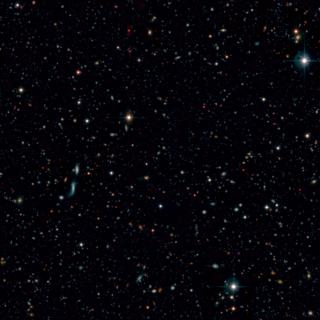Bibcode
Petropoulou, V.; Vílchez, J.; Iglesias-Páramo, J.; Papaderos, P.; Magrini, L.; Cedrés, B.; Reverte, D.
Referencia bibliográfica
The Astrophysical Journal, Volume 734, Issue 1, article id. 32 (2011).
Fecha de publicación:
6
2011
Revista
Número de citas
25
Número de citas referidas
24
Descripción
Spatially resolved spectroscopy has been obtained for a sample of 27
star-forming (SF) galaxies selected from our deep Hα survey of the
Hercules cluster. We have applied spectral synthesis models to all
emission-line spectra of this sample using the population synthesis code
STARLIGHT and have obtained fundamental parameters of stellar components
such as mean metallicity and age. The emission-line spectra were
corrected for underlying stellar absorption using these spectral
synthesis models. Line fluxes were measured and O/H and N/O gas chemical
abundances were obtained using the latest empirical calibrations. We
have derived the masses and total luminosities of the galaxies using
available Sloan Digital Sky Survey broadband photometry. The effects of
cluster environment on the chemical evolution of galaxies and on their
mass-metallicity (MZ) and luminosity-metallicity (LZ) relations were
studied by combining the derived gas metallicities, the mean stellar
metallicities and ages, the masses and luminosities of the galaxies, and
their existing H I data. Our Hercules SF galaxies are divided into three
main subgroups: (1) chemically evolved spirals with truncated
ionized-gas disks and nearly flat oxygen gradients, demonstrating the
effect of ram-pressure stripping; (2) chemically evolved
dwarfs/irregulars populating the highest local densities, possible
products of tidal interactions in preprocessing events; and (3) less
metallic dwarf galaxies that appear to be "newcomers" to the cluster and
are experiencing pressure-triggered star formation. Most Hercules SF
galaxies follow well-defined MZ and LZ sequences (for both O/H and N/O),
though the dwarf/irregular galaxies located at the densest regions
appear to be outliers to these global relations, suggesting a physical
reason for the dispersion in these fundamental relations. The Hercules
cluster appears to be currently assembling via the merger of smaller
substructures, providing an ideal laboratory where the local environment
has been found to be a key parameter in understanding the chemical
history of galaxies.
Proyectos relacionados

Evolución de Galaxias
El estudio de la evolución de las galaxias es un tema crucial de la Astronomía Extragaláctica moderna. Permite vincular las galaxias locales con las primeras que existieron en el universo. Pero para poder abordarlo es preciso obtener censos estadísticamente significativos de galaxias de distintas luminosidades, a distintas distancias
Jorge
Cepa Nogue